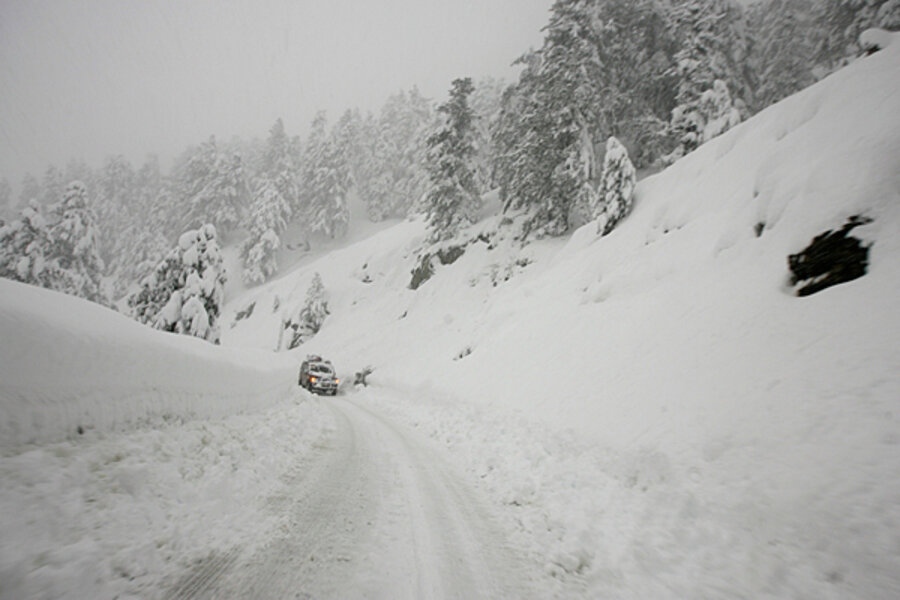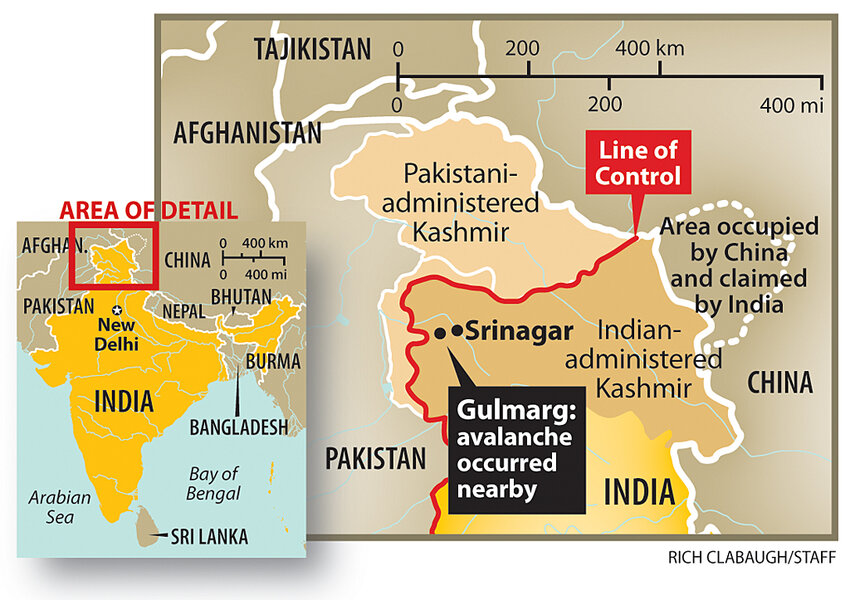Kashmir avalanche strikes near popular ski resort
Loading...
| Gulmarg, India
An avalanche on the India-Pakistan border, which killed at least 17 Indian soldiers Monday, struck near a popular ski resort meant to showcase peaceful progress in the long-disputed state of Kashmir.
The avalanche occurred a few miles from the Kashmir resort, striking an Indian Army high-altitude training camp near the heavily militarized Line of Control with Pakistan. Both India and Pakistan claim the Himalayan state of Kashmir and have fought three wars over it.
Over the weekend, skiers in Gulmarg had expressed concerns that days of intense snow were creating risky avalanche conditions.
Indian ski guides, who normally are hired by the burgeoning numbers of foreign skiers, worked into the evening to help with rescue efforts, according to local ski outfitter Yasin Khan. No tourists were hurt.
The Indian government developed Gulmarg as a ski destination to exhibit peaceful progress in Kashmir. In years of calm, including the past decade , the resort has flourished. But the occasional flare-ups in Kashmir including street rioting and curfews in the capital last week – and now the avalanche – deal temporary setbacks to the determination of men like Mr. Khan to rebrand Kashmir as a place of tourism, not terrorism.
"Skiing will bring here more peace and get more money from all over the world. And tourism dollars go not just in one pocket [at a time], but in 20," says Khan.
Tourism, not terrorism
Some 2,000 tourists now come to Gulmarg in the winter, Khan estimates. That's up from 250 five years ago, and nearly zero in the years following the Kargil conflict in 1999 between India and Pakistan. With a $14 day pass, skiers can be swooped up to 13,000 feet on a two-stage gondola, which operators keep alive during power outages with the help of a generator. A couple of small lodges offer plates of mutton, bowls of tomato soup, and stacks of buttery chapatis.
Besides miles of trackless terrain and bountiful powder, the frisson of danger attracts skiers, including just this weekend some from the US, Canada, South Africa, Australia, and Austria. As guide Chris Werren put it on Sunday "a little bit of risk that is involved to go to this place" adds to the experience.
Indian soldiers on rotating deployment typically pack the Srinigar airport and groups of half dozen men in fatigues march alongside the two-hour serpentine drive to the slopes.
Rumblings of an avalanche
Avalanches remain top of the mind. The resort takes avalanche control measures under the lifts but not elsewhere, adding some peaceful booms to the border region.
Lately outfitters like Khan have been offering avalanche beacons and probes. Those monitoring the snow for the skiers had predicted avalanches would come.
The website gulmargsnowsafety.com warned Friday of "HIGH potential for climax avalanches," adding: "when strong winds on Sunday and Monday create slab conditions, expect widespread natural avalanches from this weak interface throughout the alpine region."
It's not clear yet what precautions, if any, the military took in the face of the warnings. The avalanche was triggered when 70 troops were taking a skiing test.
The Army produces skilled alpinists who occasionally trade potshots with the Pakistanis in the nearby Siachen glacier region, dubbed "the world's highest battlefield."
They also are sending India's only two Olympic skiers to Vancouver.
Now, too popular?
Unlike Saichen, Gulmarg has been left out of the fighting, perhaps because the village has no permanent residents. But conflict has at times wiped out the budding tourism at the hill station.
High-profile kidnappings in a different part of Kashmir in 1995, and then the Kargil conflict – also centered elsewhere – almost ended a rental and guide business that Khan built up from money he had saved as a porter in the 1970s.
"Gulmarg was mine, I had no clients, no skiers," says Khan, who spent two years teaching himself to ski on equipment purchased from British tourists. "I was enjoying the mountains [but] with no money. God would give me two or three backpackers to get a little money to survive."
That changed in 2003 with articles beginning to appear in international outdoor and skiing publications. By the middle of the decade, the Himalayan town had become a favorite place for dedicated skiers to spend a season as "ski bums," says Mr. Werren. Now, he worries "the Goa people" – or those who come more to party than to seriously ski – have discovered Gulmarg. "A few more years and the partiers will overtake the pace."






